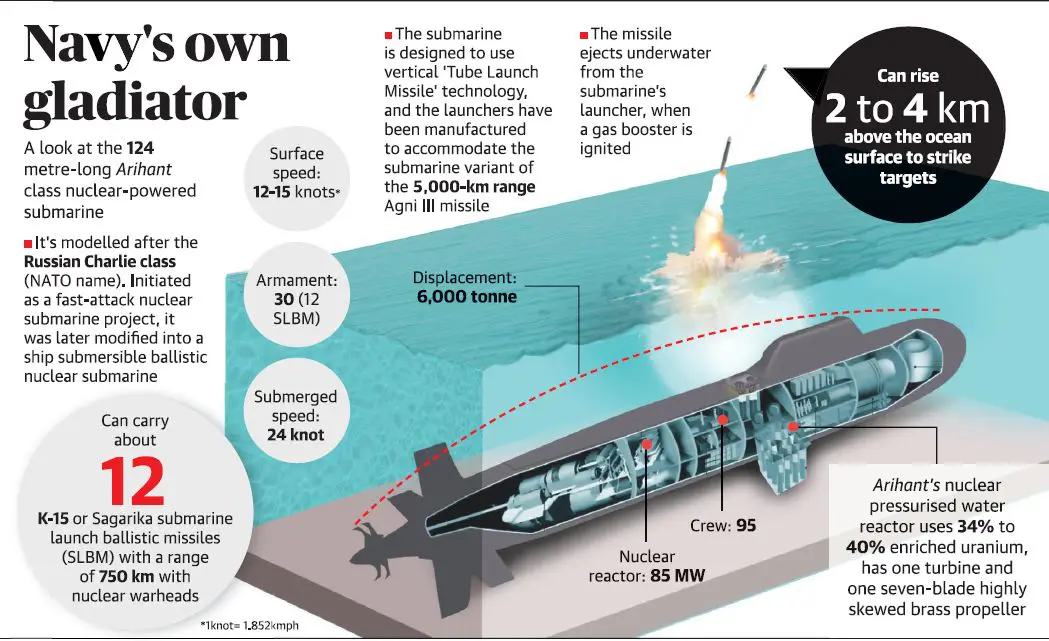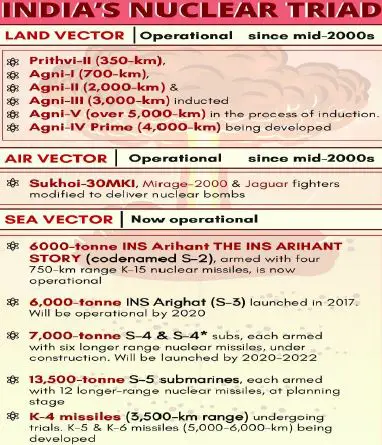Table of Contents
Nuclear Triad india – INS Arihant Submarine UPSC – IAS
The indigenous INS Arihant, India’s first nuclear-powered submarine successfully completed its first deterrence patrol, meaning that the submarine is fully ready for its role as a strategic deterrent.
Significance of Nuclear Triad | UPSC – IAS
- With the completion of the patrol, India have finally achieved the longstanding ambition to have a nuclear triad, giving the country multiple options if it comes to a nuclear confrontation. Nuclear Triad
- A nuclear triad refers to the three components of atomic weapons delivery: strategic bombers, intercontinental ballistic missiles (ICBMs) and submarine launched ballistic missiles (SLBMs).
- Of the three elements of the triad, the SLBMs are considered the most important because the nuclear-powered ballistic missile submarine is the hardest to detect, track and destroy.
- A nuclear triad gives a country the ability to launch nukes from land, air and sea. This is important, because if a country initiates a nuclear attack, it cannot destroy all three components of the triad at once, and thus, the component which is intact can launch a retaliatory strike.
Uniqueness of each leg of Triad | UPSC – IAS
According to Undersea Warfare, the Official Magazine of the US submarine force, each leg of the triad contributes unique attributes that enhance deterrence and reduce risk.
- ICBMs provide a prompt response, the potential to launch under attack, and a hardened, geographically-
dispersed target base. - Strategic bombers provide great flexibility in force posturing, signalling intentions, route planning, and recall-ability.
- Missile submarines provide survivable, assured response and the mobility to adapt missile over-flight to targets.
Why India needs a Nuclear Triad ? | UPSC – IAS
- India’s ‘No first use’ nuclear policy (NFU) talks of minimum credible deterrence. Minimum credible deterrence capability would, however, require India to possess the critical capabilities to ensure the survivability of its nuclear weapons even after a first strike against it. NFU, therefore, casts a responsibility on the nation to achieve a second strike capability. A second strike capability can only be imparted by a Triad.
- India has two nuclear-armed countries (China and Pakistan) on both its eastern and western fronts which makes it particularly imperative for the country to possess adequate deterrence.
- The absence of INS Arihant came to attention during the Doka La standoff with China, when Beijing had flexed muscle in the Indian Ocean. The Indian Ocean Region, crucial for India’s strategic interests, has in general been witnessing an increasing presence of Chinese ships and submarines.
- Chinese String of Pearls and Maritime Silk Road are attempting to create a Chinese monopoly in the Indian Ocean Region while encircling India from Myanmar to West Asia and Eastern Africa.
- Pakistan last year tested its submarine-launched Babur missile, and in the process completed its nuclear triad, since it already possesses land-based ballistic missiles as well as tactical nuclear bombs that it can drop from its fighter aircraft.
- India now joins the elite squad of countries like Russia, China, France, the US and the UK that possess nuclear-powered submarines. It is the first SSBN (Ship Submersible Ballistic Nuclear) to have been built by a country other than one of the five permanent members of the United Nations Security Council.
A Way forward | UPSC – IAS
- More requirement of SSBN: According to the US Navy Institute, a continuous patrol requires a minimum of four SSBNs. This assumes one submarine is on patrol for, say, two to three months; another is in port on standby; while the third and fourth may be undergoing repairs or refits. In this context India needs to speed up its Advanced Technology Vessel (ATV) project to ensure timely delivery of SSBNs.
- Complementary fleet to SSBN: India will require a complementary fleet of ship submersible nuclear (SSN) submarines – these are fast, hunter killer subs that will be required to detect and track Chinese and Pakistani undersea activity and warships. The Indian Navy plans to acquire as many as six SSNs, and discussions are on with shipbuilders from France and the US for participating in the project.
- Nuclear Submarine Base: The Indian Navy has commenced Project Varsha – the construction of a massive nuclear submarine base south of Visakhapatnam. The base will house India’s SSBN fleet. The first phase of the project will be completed by 2022. Its timely completion is crucial for India’s Oceanic leg of Nuclear Triad.
- Enhance the range of Missiles: The Arihant is equipped to carry twelve K-15 ballistic nuclear missiles with an abysmally short range of 750 km. This means before launching its missiles, the sub will have to venture close to enemy waters, endangering its own security. A 3,500 km range missile named the K-4 is currently in development. Apart from this, DRDO is also developing 5,000-km range K-5 and 6,000-km range K-6 which would add more teeth to the arsenal.





